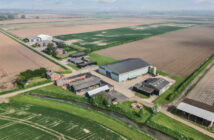A crop of LG Skyscraper that achieved 16.6 t/ha has won gold for Lincolnshire farmer Mark Stubbs in the ADAS YEN (Yield Enhancement Network) cereals competition.
Mr Stubbs also won the competition with another 16 t/ha crop in 2019, the variety being KWS Siskin.
He believes his success is down to attention to detail, with delayed drilling, widespread use of farmyard manures and a move away from ploughing.
The 120-hectare block on the Lincolnshire Wolds is heavy clay, on which Mr Stubbs has grown Skyscraper for several years. It has always performed well, averaging 10.5 tonnes over this time and it has also delivered consistent grain quality.
Last year’s crop followed oilseed rape, which was allowed to green up following harvest to act as a catch crop. Cultivations comprised a tine and disc cultivator, with a packer, followed by a second pass with a disc cultivator. Drilling was delayed by a week due to wet weather, going in on the 11th of November at a rate of 250kg per hectare, with the aim of plant populators of 275 plants per m2.
Mr Stubbs aims to produce a thick, competitive crop that has immediate access to nutrients so that it can get away strongly and outcompete any blackgrass. “LG Skyscraper has a fairly vigorous growth habit once it germinates, so I don’t worry about sowing it later, as I might with some other varieties,” he said.
Manures are applied to stubble and incorporated within six hours. This has seen soil organic matter rise from an index of 2 to 10, despite the acidic, calciferous soils. “We find that the nutrition contained in the manures kicks in early on, giving the crop a good start.”
For his winning crop, liquid nitrogen (225N 10%S) was applied in three doses, four weeks apart, receiving an average of 210kg per hectare, excluding the manures. This little and often approach along with in-season monitoring allows him to fine-tune requirements.
With a Septoria rating of 4.9 he feels it is important to get on top of the disease early so he is not chasing it through this season.
Despite being slightly taller-strawed, lodging in LG Skyscraper has never been an issue even on the more fertile Wold soils. PGR’s are used when needed, which was the case last season. “As last year’s crop was grown on the March site with heavier soils, crop emergence and growth were slower, and coupled with late drilling, the crop didn’t reach a leggy stage, so a robust T1 was used which proved sufficient to regulate the crop.”
The Skyscraper crop was harvested on the 10th of August, early for such a late-drilled crop. “It literally turned overnight, it wasn’t ripe when we checked it two days before, so I think we caught it just in time,” he concluded.




